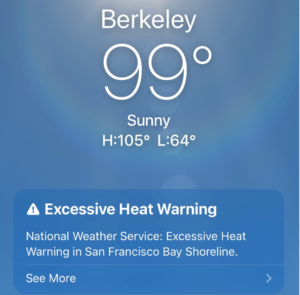
by Nina
Although many of you in the Northern Hemisphere are now excited about the advent of cooler Autumn days or are mourning the end of summer, in Berkeley, California, where I live, we’re experiencing our first real heat of the summer. Even though it is typically very temperate here, there are seasons (though some people might argue differently). It’s just that our summer heat tends to happen a bit later in the year than it does in most other places. So the hottest time of year is late August and September.
However, in the last few years, global warming has increased normal summer heat levels here in the San Francisco Bay Area the same way it has world wide. Yesterday was very hot here, and as I write this, I’m expecting another very hot day. In fact, predictions are that today will be the hottest day ever recorded in the San Francisco Bay Area and Sacramento Regions. But because it’s normally so temperate here in Berkeley, we don’t have air conditioning in our house so it will be hot inside the house as well as outside. And that means I’m thinking about how to adapt my yoga practice from the way I’ve been practicing the rest of the summer. Is the weather—or the season—something that you think about when deciding what to practice or teach to your students?
Many years ago, I had a very memorable experience in how to adapt a yoga practice to the day’s weather. On that particular summer day in Berkeley, it was much hotter than usual. And when I went to my regular Friday morning yoga class, I was expecting to practice backbends because my teacher, Donald Moyer, always taught backbends the second class of the month. Our studio, though in a beautiful old building, had no insulation and very little climate control, with poor heating in the winter and no air conditioning in the summer, so that morning it was unusually warm in the studio.
Donald opened the class with a little smile, saying, “Today we’re going to do some nice cooling backbends.” Everyone laughed, because, of course, backbends are typically not at cooling. But guess what. We did do backbends, but Donald modified his typical sequence so we did a cooler practice of stretches, passive backbends, and the less effortful, active backbends, rather than a “hotter” practice of standing poses and very active backbends.
That memory of that still makes me smile, but I’m bringing it up today because there are actually very good reasons to change your practice if it’s too hot or too cold in the room where you practice.
Being too hot is actually very stimulating. Your nervous system warns your body and mind that you may be in danger! So it’s stressful to do very active poses that heat you up even more. And, of course, it can even dangerous for some people to overheat, especially older people, because it puts so much stress on your body. That’s why when it’s hot, it’s a good time to do more passive and relaxing poses. Or, slowly work up to the active poses and take time to rest and cool down.
On the other hand, being too cold also stimulates your nervous system, warning your body and mind that you may be in danger the same way as when you’re too hot. So it’s very difficult to relax in a cold room. For example, a restorative practice in a cold room is not only very challenging because you get colder and colder the longer you stay still, but it is also not very effective. On the other hand, the active poses warm up both you and the room quite nicely.
Naturally you don’t want to do only active practices all winter and only passive practices all summer, but as my teacher did that day, you modify any sequence by adding more cooling poses or heating poses to accommodate the climate, both outdoors and indoor. For your convenience, I’ve categorized the general groups of poses into Heating and Cooling. After this, I’ll share some links to articles we have on the blog that address practicing yoga in during the fall season specifically.
Heating Poses
- Sun Salutations
- Standing Poses
- Active backbends
- Headstand and arm balances
- Twists and abdominal strengtheners
Cooling Poses
- Restorative poses
- Reclined poses
- Forward bends
- Supported inverted poses
Some other considerations: Your body is stiffer when you are cold, so that’s a time when you may need more stretching. When it’s hot and your muscles are more relaxed, you may not need to stretch as much. The weather also influences how physically active you are outside the yoga room. I also tend to be more physically active outside during warmer, drier months, walking, gardening, and so on. So to balance my body on more active days, I’ll focus more on poses that complement those activities (see Deciding What to Practice). During the rainy season when I spent more time in the house, I’ll naturally gravitate toward more active poses to compensate for being more sedentary. However, some people may spend the winter skiing (yes, I’ve heard tell of that) and the summer hiding out in an air-conditioned apartment (heard of that, too), so each person needs to find his or her own way with figuring out the best practice on a given day.
Articles About Practicing Yoga in the Fall
Healthy Living for Fall with Ayurveda and Yoga by Ram Rao, who is a doctor of Ayurveda
Autumn, Healthy Aging and the Ayurvedic Dosha Vata by Timothy McCall, who has studied Ayurveda in depth in India
• Follow Yoga for Healthy Aging on Facebook and follow Nina on Instagram • Order Yoga for Times of Change here and purchase the companion videos here • Order Yoga for Healthy Aging: A Guide to Lifelong Well-Being here.


Leave A Comment